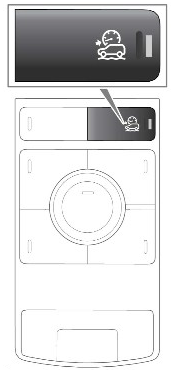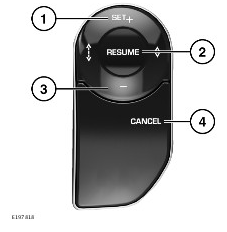2022 Land Rover Range Rover Sports All Terrain Progress Control (ATPC)

ALL TERRAIN PROGRESS CONTROL (ATPC) OVERVIEW
Use extreme care when maneuvering the vehicle in a reverse direction, to avoid serious injury or death.
The All Terrain Progress Control (ATPC) system helps the driver to maneuver the vehicle on slippery surfaces, e.g., snow, grass, gravel, sand, or mud.
When the ATPC system is enabled, with the brake pedal fully released, the system helps to provide controlled and progressive assistance for the vehicle to:
- Maintain an automatically set low speed, for a steep descent. See DESCENT CONTROL MODE.
- Make progress and maintain a driver-selected set speed, up to a maximum of 19 mph (30 km/h). See FULL FUNCTION MODE.
- Pull away from a standstill, in a forward or reverse direction on level ground, and uphill or downhill.
- Perform low-speed maneuvering in a forward or reverse direction.
ALL TERRAIN PROGRESS CONTROL (ATPC)
Do not adjust the lower touchscreen controls, or allow the All Terrain Progress Control (ATPC) system to distract the driver, while the vehicle is moving. Driver distraction may potentially lead to an accident, resulting in serious injury or death.
Do not attempt a steep descent if the ATPC system is not enabled, or if the instrument panel displays any warning messages.
The driver must maintain full control of the steering and brakes at all times.
The ATPC system cannot be enabled if the advanced tow assist, park assist, wade sensing, or parking features are currently enabled.
The vehicle’s cruise control, speed limiter, and auto stop/start systems are disabled during operation of the ATPC system.

To enable the ATPC system, press the ATPC button, located on the center console. The instrument panel displays a message prompting to select the set speed for the vehicle. The ATPC warning lamp illuminates to confirm selection. See ALL TERRAIN PROGRESS CONTROL (ATPC) (GREEN).
The driver can override the ATPC system operation, at any time, using the brake pedal or the accelerator pedal.
The ATPC system can be enabled when the vehicle is stationary and when the vehicle is moving. When the vehicle is stationary, apply the brake pedal to maintain control of the vehicle.
The ATPC system remains enabled for 6 hours after the ignition is switched off. After this time, ATPC has to be reselected, if the system is still required when the ignition is switched on.
Press and release the ATPC button again to disable the system. The instrument panel extinguishes the ATPC warning lamp to confirm deselection.
The ATPC system operation is influenced by the current terrain response driving program selection. For example, the grass gravel snow program requires gradual ATPC acceleration to help gain available wheel traction. The comfort program allows increased ATPC acceleration to help improve vehicle progress. See TERRAIN RESPONSE OPERATION.
USING ALL TERRAIN PROGRESS CONTROL (ATPC)
The All Terrain Progress Control (ATPC) system has two modes of operation:
- Descent control mode: Is the default setting when the ATPC system is enabled and the vehicle is stationary. See DESCENT CONTROL MODE.
The ATPC system uses the braking system to maintain an automatically set low speed, for driving down a steep descent.
- Full function mode: Is automatically entered, when the ATPC system detects the driver has requested a higher set speed, via the operation of the steering wheel’s SET + button. See FULL FUNCTION MODE.
The ATPC system maintains the higher set speed by using the braking system and engine torque. Full function mode should be used for all other maneuvers that require the vehicle to gain and make progress. For example, making an ascent, pulling away from a standstill, and driving on unstable and slippery driving surfaces.
The ATPC system automatically exits full function mode and reverts back to descent control mode, in the event that:
- Neutral (N) or Park (P) is selected.
- The Electric Parking Brake (EPB) is applied.
- The vehicle’s brakes are firmly applied during operation of the ATPC system.
- The vehicle is brought to a standstill via light and gentle application of the brake pedal.
In all of the previously listed events, the instrument panel displays a relevant information message.
In the event that the vehicle’s brake temperatures exceed the normal operating limits, the instrument panel displays a warning message. In this event, The ATPC system operation fades out and becomes temporarily inactive. When the brakes return to normal operating temperatures, the message extinguishes and the system resumes normal operation.
If an ATPC system fault is detected, the instrument panel displays a message indicating that ATPC is not available.
Some detected faults may allow the ATPC system to operate in descent control mode only. In this event, the instrument panel displays a message indicating that ATPC can only operate in descent control mode. Using the SET+ button increases the set speed for descent control mode. Switching the ignition off and on again may reset the ATPC system.
If a detected fault persists, consult a retailer/authorized repairer.
DESCENT CONTROL MODE
When the All Terrain Progress Control (ATPC) system enters descent control mode, the instrument panel displays a confirmation message. See ALL TERRAIN PROGRESS CONTROL (ATPC) and USING ALL TERRAIN PROGRESS CONTROL (ATPC).
Operate as follows:
- Select the correct driving program for the current terrain. See TERRAIN RESPONSE OPERATION.
- Select the required position for the gear selector.
- Release the vehicle’s brakes to allow gravity to make the vehicle progress up to the descent control mode’s default speed. The currently selected terrain response driving program determines the descent control mode’s default speed. The default speed varies from a minimum of 1.1 mph (1.8 km/h) in low range and up to a maximum of 7.5 mph (12 km/h) in high range. See SELECTING HIGH AND LOW RANGE.
- The ATPC system maintains the descent control mode’s default speed. ATPC exits descent control mode if it detects the use of the accelerator pedal or the steering wheel’s SET+ button. See ALL TERRAIN PROGRESS CONTROL (ATPC) SETTINGS.
NOTES
Descent control mode resumes when the accelerator pedal is released, and the steering wheel’s SET+ button is not used.
FULL FUNCTION MODE
When the All Terrain Progress Control (ATPC) system enters full function mode, the instrument panel displays a prompt message to select the desired set speed. See ALL TERRAIN PROGRESS CONTROL (ATPC) SETTINGS and USING ALL TERRAIN PROGRESS CONTROL (ATPC).
The driver’s seat belt must be buckled and all of the doors must be closed to enable the ATPC system to enter full function mode. If these conditions are not met, the instrument panel displays a warning message.
If the low traction launch feature is currently enabled, it is disabled when the ATPC system enters full function mode. See LOW TRACTION LAUNCH.
ALL TERRAIN PROGRESS CONTROL (ATPC) SETTINGS
When the vehicle is stationary, press and hold the brake pedal to maintain control of the vehicle while using the SET+ button.
Light and gentle application of the accelerator pedal temporarily overrides the current set speed. Release the accelerator pedal to revert the All Terrain Progress Control (ATPC) system back to the previously selected set speed.
Selecting very low speeds when pulling away on slippery surfaces can affect the vehicle’s ability to make progress. For improved pulling away performance, it is recommended to select a set speed that is sufficient to maintain the vehicle’s progress.
Light and gentle application of the brake pedal lowers the set speed. When the brake pedal is fully released, the ATPC system maintains the speed at which the vehicle was traveling when the brake pedal was released. If the brake pedal is pressed when the ATPC system is active, a slight pulsation movement may be felt through the brake pedal.

When the ATPC system is enabled, the desired set speed for the vehicle can be set and adjusted. Use the controls mounted on the right side of the steering wheel.
- SET+ button: Press once to enable the ATPC system to recognise that the desired set speed is to be set and adjusted. Press repeatedly, or press and hold, to increase the set speed, up to a maximum speed of 19 mph (30 km/h). Alternatively, when driving, press the SET+ button for the vehicle’s current speed to be the set speed. The instrument panel displays the current set speed.
- RESUME button: Press to resume the set speed if the vehicle’s speed has been lowered via gentle application of the brake pedal.
WARNING
RESUME should only be used if the driver is aware of the set speed and intends to return to it. Inappropriate use can potentially lead to vehicle damage or personal injury.
- – button: Press and release repeatedly, or press and hold, to decrease the desired set speed. The minimum feature speed is 2.2 mph (3.5 km/h) in high range or 1.1 mph (1.8 km/h) in low range. See SELECTING HIGH AND LOW RANGE.
- CANCEL button: Press to exit full function mode and revert the ATPC system to descent control mode. See USING ALL TERRAIN PROGRESS CONTROL (ATPC).
NOTES
Pressing the CANCEL button retains the set speed for future use, unless the ATPC system or the ignition system is switched off.
The incremental increases or decreases of the set speed are influenced by the current set speed:
- 0.3 mph (0.5 km/h) increments if the set speed is between 0 and 3 mph (0 and 5 km/h).
- 0.6 mph (1 km/h) increments if the set speed is between 3 and 6 mph (5 and 10 km/h).
- 1.2 mph (2 km/h) increments if the set speed is between 6 and 19 mph (10 and 30 km/h).
When the vehicle is traveling at speeds between 19 mph (30 km/h) and 50 mph (80 km/h), the ATPC system operation is suspended. In this event, the ATPC warning lamp flashes. The ATPC system operation resumes when the vehicle’s speed is less than 19 mph (30 km/h). If the vehicle’s speed exceeds 50 mph (80 km/h), the ATPC system disables. The ATPC warning lamp extinguishes. If required, the ATPC system has to be switched on again. See ALL TERRAIN PROGRESS CONTROL (ATPC) (GREEN).

